
original at www.af.mil |
F-22 shot from F-16 chase
(F-22 Team photo courtesy Lockheed Martin-Boeing )
On September 7, 1997 the first Lockheed Martin-Boeing F-22 Raptor air dominance fighter for the U. S. Air Force was flown for the first time taking to the skies over Marietta and north Georgia. F-22 Chief Test Pilot Paul Metz flew the aircraft from Dobbins Air Reserve Base here, lifting off the runway at 140 knots with the aircraft's two Pratt & Whitney F119-PW-100 engines at military power. The aircraft reached an altitude of 15,000 feet in less than three minutes, then was put through a series of power changes to test aircraft handling characteristics and engine performance. Midway through the flight, Metz climbed to 20,000 feet and retracted the F-22's landing gear. He then conducted more engine transients, evaluated the jet's performance in "clean" configuration, and flew formation on a chase F-16 to evaluate precision handling characteristics before landing back at Dobbins ARB. |
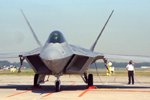
original at www.af.mil |
Ground crew and F-22 prior to first flight
(F-22 Team photo courtesy Lockheed Martin-Boeing )
On September 7, 1997 the first Lockheed Martin-Boeing F-22 Raptor air dominance fighter for the U. S. Air Force was flown for the first time taking to the skies over Marietta and north Georgia. F-22 Chief Test Pilot Paul Metz flew the aircraft from Dobbins Air Reserve Base here, lifting off the runway at 140 knots with the aircraft's two Pratt & Whitney F119-PW-100 engines at military power. The aircraft reached an altitude of 15,000 feet in less than three minutes, then was put through a series of power changes to test aircraft handling characteristics and engine performance. Midway through the flight, Metz climbed to 20,000 feet and retracted the F-22's landing gear. He then conducted more engine transients, evaluated the jet's performance in "clean" configuration, and flew formation on a chase F-16 to evaluate precision handling characteristics before landing back at Dobbins ARB. |
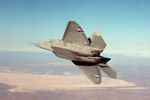
original at www.af.mil |
F-22 banks right over Edwards AFB
(Photo courtesy Lockheed Martin)
The F-22 banks right during it's flight over Edwards Air Force Base, Calif. The F-22 is widely regarded as the most advanced fighter in the world, combining a revolutionary leap in technology and capability with reduced support requirements and maintenance costs. It is destined to replace the aging F-15 as America's front-line air superiority fighter, with deliveries beginning in 2002. The F-22's combination of stealth, integrated avionics, maneuverability, and supercruise (supersonic flight without afterburner) will give Raptor pilots a first-look, first-shot, first-kill capability against the aircraft of any potential enemy. The F-22 is designed to provide not just air superiority, but air dominance, winning quickly and decisively with few U. S. and allied casualties. The F-22 also has an inherent near precision air-to-ground capability. |
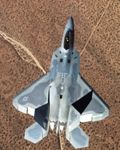
original at www.af.mil |
F-22 Raptor over Mojave Desert
(Photo courtesy Lockheed Martin)
Raptor 01 passes over the Mojave Desert near Edwards Air Force Base, Calif. The F-22 is widely regarded as the most advanced fighter in the world, combining a revolutionary leap in technology and capability with reduced support requirements and maintenance costs. It is destined to replace the aging F-15 as America's front-line air superiority fighter, with deliveries beginning in 2002. The F-22's combination of stealth, integrated avionics, maneuverability, and supercruise (supersonic flight without afterburner) will give Raptor pilots a first-look, first-shot, first-kill capability against the aircraft of any potential enemy. The F-22 is designed to provide not just air superiority, but air dominance, winning quickly and decisively with few U. S. and allied casualties. The F-22 also has an inherent near precision air-to-ground capability. |
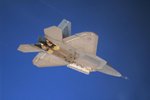
original at www.af.mil |
F-22 Raptor with weapons bay open
(U.S. Air Force photo courtesy of the F-22 Combined Test Force)
An F-22 demonstrates its weapon-carrying capabilities during a flight over the Mojave Desert in November 1998. America's new fighter aircraft, the F-22 Raptor, continues to impress during its flight testing at Edwards Air Force Base, Calif. With nearly three hours of supersonic flight, 79 total flights and 164.2 flight hours logged, the Air Force's chosen successor to the F-15 Eagle air superiority fighter is on a roll. |
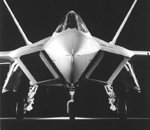
original at www.af.mil |
F-22 Raptor
(Coutesy photo)
The F-22 Raptor is the most advanced fighter aircraft in the world, combining a revolutionary leap in technology and capability with reduced support requirements and maintenance costs. The F-22's combination of stealth, integrated avionics, maneuverability, and supercruise � supersonic flight without afterburner � will give Raptor pilots a first-look, first-shot, first-kill capability against the aircraft of any potential enemy. The Raptor is designed to provide not only air superiority, but air dominance, winning quickly and decisively with few U.S. and allied casualties. The Raptor also has an inherent air-to-ground capability. |
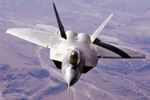
original at www.af.mil |
F-22 Raptor flys a test mission
(U.S. Air Force photo by Technical Sgt. Lono Kollars)
The F-22 is an air-superiority fighter with improved capability over current USAF aircraft. From the inception of the battle, the F-22's primary objective will be to establish air superiority through the conduct of counter air operations. The F-22 also has an inherent air-to-surface capability. A combination of improved sensor capability, improved situational awareness, and improved weapons provides first-kill opportunity against the threat. The F-22 possesses a sophisticated sensor suite that allow the pilot to track, identify, and shoot the threat before it detects the F-22. Significant effort is being placed on cockpit design and avionics fusion to improve the pilot's situational awareness. Advanced avionic technologies allow the F-22 sensors to gather, integrate, and display essential information in the most useful format to the pilot. |
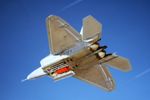
original at www.af.mil |
F-22 Raptor #02 with its weapons bay open
(U.S. Air Force Photo)
F-22 Raptor #02 with its weapons bay open shows AIM-120 advanced medium-range air-to-air missiles (AMRAAM) with a full instrument suite. AMRAAM and open bay tests proved completely successful during April 1999 testing at Edwards Air Force Base, Calif. The F-22 is an air superiority fighter designed to dominate the air environment in the 21st Century. Key features include low radar observability (with internal weapons carriage) and supersonic cruise which retain superior maneuverability, wide field-of-regard offensive and defensive sensors, multi-spectral countermeasures, and high reliability. Basic armament of the F-22 will consist of six AIM-120C missiles, two AIM-9 missiles, and a 20mm cannon. |
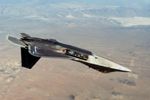
original at www.af.mil |
F-22 Raptor Capabilities
(U.S. Air Force Photo)
The F-22 is an air-superiority fighter with improved capability over current USAF aircraft. From the inception of the battle, the F-22's primary objective will be to establish air superiority through the conduct of counter air operations. The F-22 also has an inherent air-to-surface capability. The F-22 incorporates the latest technological gains in reduced observables, avionics, engine performance, and aerodynamic design. Knowledge gained from proven weapon systems such as the F-15, F-16 and the F-117A formed the foundation for F-22 development. The F-22's armament can consist of one M61A2 20 millimeter multibarrel cannon; internal stations can carry AIM-9 infrared (heat seeking) air-to-air missiles and AIM-120 radar-guided air-to-air missiles or 1,000 pound Joint Direct Attack Munitions (JDAMS); external stations can carry additional stores. |

original at www.af.mil |
F-22 Raptor in full afterburner
(U.S. Air Force Photo)
An F-22 Raptor in full afterburner during flight testing at Edwards Air Force Base, Calif. The F-22 is an air dominance fighter with much-improved capability over current Air Force aircraft. From the inception of the battle, the F-22's primary objective will be to establish absolute control of the skies through the conduct of counterair operations. The fighter also has an inherent precision ground attack capability. Threats that the F-15 will no longer be able to counter will be defeated by the lethal and survivable F-22, with its balance of increased speed and range, enhanced offensive and defensive avionics, and reduced observability. The F-22's design also emphasizes reliability and maintainability of systems. The F-22 is capable of carrying existing and planned medium and short range air-to-air missiles in internal bays. The F-22 will also have an internal 20-mm cannon and provisions for carrying precision ground attack weapons. |

original at www.af.mil |
F-22 Raptor air-superiority fighter
(Photo courtesy Lockheed Martin)
The F-22 is an air-superiority fighter with improved capability over current USAF aircraft. From the inception of the battle, the F-22's primary objective will be to establish air superiority through the conduct of counter air operations. The F-22 also has an inherent air-to-surface capability. The F-22 incorporates the latest technological gains in reduced observables, avionics, engine performance, and aerodynamic design. Knowledge gained from proven weapon systems such as the F-15, F-16 and the F-117A formed the foundation for F-22 development. The F-22's armament can consist of one M61A2 20 millimeter multibarrel cannon; internal stations can carry AIM-9 infrared (heat seeking) air-to-air missiles and AIM-120 radar-guided air-to-air missiles or 1,000 pound Joint Direct Attack Munitions (JDAMS); external stations can carry additional stores. |
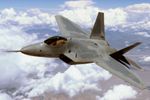
original at www.af.mil |
F-22 Raptor soars high above the Mojave Desert
(Photo by Judson Broehmer)
An F-22 Raptor soars high above the Mojave Desert. The Air Force's new air superiority fighter will dominate the future air combat arena by integrating advanced avionics, stealth and supercruise. With approximately 80 percent of development complete and two test aircraft flying, the F-22 program is nearing completion of a 13-year development program. |

original at www.af.mil |
Media take closer look at F-22 Raptor
(U.S. Air Force Photo by Ray Johnson)
EDWARDS AIR FORCE BASE, Calif. (AFPN) -- An F-22 Raptor pulls in behind a KC-135 tanker from the 452nd Flight Test Squadron. The refueling was part of a Sept. 22 West Coast Media Day for the F-22. Thirty reporters flew aboard the KC-135 tanker, watching the refueling, and also interviewed Raptor ground crews. |
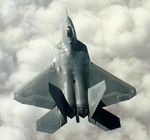
original at www.af.mil |
F-22 Raptor over the top
(U.S. Air Force Photo)
The F-22 is an air-superiority fighter with improved capability over current USAF aircraft. From the inception of the battle, the F-22's primary objective will be to establish air superiority through the conduct of counter air operations. The F-22 also has an inherent air-to-surface capability. A combination of improved sensor capability , improved situational awareness, and improved weapons provides first-kill opportunity against the threat. The F-22 possesses a sophisticated sensor suite that allow the pilot to track, identify, and shoot the threat before it detects the F-22. Significant effort is being placed on cockpit design and avionics fusion to improve the pilot's situational awareness. Advanced avionic technologies allow the F-22 sensors to gather, integrate, and display essential information in the most useful format to the pilot. |
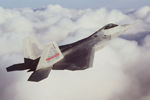
original at www.af.mil |
F-22 Raptor in the clouds during a test flight
(U.S. Air Force Photo)
The F-22 is an air-superiority fighter with improved capability over current USAF aircraft. From the inception of the battle, the F-22's primary objective will be to establish air superiority through the conduct of counter air operations. The F-22 also has an inherent air-to-surface capability. A combination of improved sensor capability , improved situational awareness, and improved weapons provides first-kill opportunity against the threat. The F-22 possesses a sophisticated sensor suite that allow the pilot to track, identify, and shoot the threat before it detects the F-22. Significant effort is being placed on cockpit design and avionics fusion to improve the pilot's situational awareness. Advanced avionic technologies allow the F-22 sensors to gather, integrate, and display essential information in the most useful format to the pilot. |
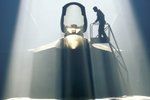
original at www.af.mil |
F-22 Raptor operations
(Photo by Eric Schulzinger)
The F-22 Raptor is an air-superiority fighter with improved capability over current USAF aircraft. From the inception of the battle, the F-22's primary objective will be to establish air superiority through the conduct of counter air operations. The F-22 also has an inherent air-to-surface capability. Armament: One M61A2 20 millimeter multibarrel cannon; internal stations can carry AIM-9 infrared (heat seeking) air-to-air missiles and AIM-120 radar-guided air-to-air missiles or 1,000 pound Joint Direct Attack Munitions (JDAMS); external stations can carry additional stores. |
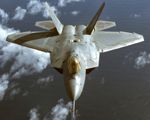
original at www.af.mil |
F-22 Raptor just prior to refueling
(Photo by Judson Brohmer)
The F-22 Raptor is an air-superiority fighter with improved capability over current USAF aircraft. From the inception of the battle, the F-22's primary objective will be to establish air superiority through the conduct of counter air operations. The F-22 also has an inherent air-to-surface capability. Armament: One M61A2 20 millimeter multibarrel cannon; internal stations can carry AIM-9 infrared (heat seeking) air-to-air missiles and AIM-120 radar-guided air-to-air missiles or 1,000 pound Joint Direct Attack Munitions (JDAMS); external stations can carry additional stores. |
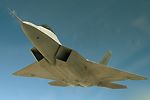
original at www.af.mil |
Underside view of F-22 Raptor
(Photo by Judson Brohmer)
The F-22 Raptor is an air-superiority fighter with improved capability over current USAF aircraft. From the inception of the battle, the F-22's primary objective will be to establish air superiority through the conduct of counter air operations. The F-22 also has an inherent air-to-surface capability. Armament: One M61A2 20 millimeter multibarrel cannon; internal stations can carry AIM-9 infrared (heat seeking) air-to-air missiles and AIM-120 radar-guided air-to-air missiles or 1,000 pound Joint Direct Attack Munitions (JDAMS); external stations can carry additional stores. |
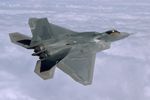
original at www.af.mil |
F-22 Raptor flies a test mission over southern California
(Photo by Judson Brohmer)
The F-22 Raptor is an air-superiority fighter with improved capability over current USAF aircraft. From the inception of the battle, the F-22's primary objective will be to establish air superiority through the conduct of counter air operations. The F-22 also has an inherent air-to-surface capability. Armament: One M61A2 20 millimeter multibarrel cannon; internal stations can carry AIM-9 infrared (heat seeking) air-to-air missiles and AIM-120 radar-guided air-to-air missiles or 1,000 pound Joint Direct Attack Munitions (JDAMS); external stations can carry additional stores. |

original at www.af.mil |
Raptor put through the paces
(U.S. Air Force Photo by Judson Brohmer)
EDWARDS AIR FORCE BASE, Calif. (AFPN) -- F-22 Raptor 4001 turns on its afterburners during a high-speed, low-level test sortie here. As part of the president's proposed fiscal 2001 defense budget, nearly $4 billion is tagged for the F-22 program: $1.4 billion for research and testing being done here and $2.5 billion to buy the first 10 combat-ready fighters. The F-22 is being put through the most extensive and sophisticated testing of any fighter ever developed. |
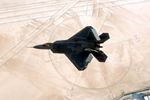
original at www.af.mil |
Raptor Over Desert Compass
(U.S. Air Force Photo by Judson Brohmer)
EDWARDS AIR FORCE BASE, Calif. (AFPN) -- F-22 Raptor 4001 flies over the Compass Rose at the Rodgers Dry Lakebed here. As part of the president's proposed fiscal 2001 defense budget, nearly $4 billion is tagged for the F-22 program: $1.4 billion for research and testing being done here and $2.5 billion to buy the first 10 combat-ready fighters. Advanced avionics technologies will allow F-22 sensors to gather, integrate and display essential data in the most useful format for future pilots. |
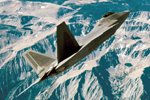
original at www.af.mil |
Raptor Over Mojave Desert Mountains
(U.S. Air Force Photo by Judson Brohmer)
EDWARDS AIR FORCE BASE, Calif. (AFPN) -- Raptor 4001 climbs over Mojave Desert Mountains during a test mission here. As part of the president's proposed fiscal 2001 defense budget, nearly $4 billion is tagged for the F-22 program: $1.4 billion for research and testing being done here and $2.5 billion to buy the first 10 combat-ready fighters. The Air Force's next-generation air superiority fighter will dominate future air combat by integrating advanced avionics, stealth and supercruise. |
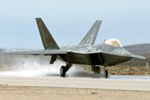
original at www.af.mil |
Raptor undergoes wet runway testing
(U.S. Air Force Photo by Derk Blanset)
EDWARDS AIR FORCE BASE, Calif. (AFPN) - Raptor 4001 undergoes wet-runway testing during a rare rainy day here in the Mojave Desert. The F-22 was tested at speeds of 30, 60 and 90 knots. This test is just one of thousands that the F-22 Combined Test Force is putting the Raptor through during the most extensive test program that any fighter aircraft has undergone. |
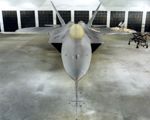
original at www.af.mil |
Boeing develops stealthy 'topcoat' for F-22 Raptor
(Lockheed Martin Aeronautical Systems photo by Derk Blanset)
Following application of the F-22 Raptor's stealthy new "topcoat" of paint at Edwards Air Force Base, Calif., a worker reapplies U.S. Air Force markings on the aircraft. Boeing developed the new paint, which will reduce vulnerability to infrared threats. |
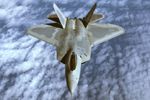
original at www.af.mil |
F-22 Raptor Air-Superiority Fighter
(Photo by Derk Blanset)
The U.S. House of Representatives defense appropriations subcommitte on May 11 endorsed spending almost $4 billion in 2001 for continued development of the F-22 Raptor. The $3.96 billion allotment would pay for 10 initial production planes and advance funding on 16 more of the next-generation air superiority fighters. The F-22 Raptor, developed at Aeronautical Systems Center, Wright-Patterson Air Force Base, Ohio, is the replacement for the F-15 Eagle air-superiority fighter and will become operational early in the next century. It combines stealth design with the supersonic, highly maneuverable, dual-engine, long-range requirements of an air-to-air fighter, and it also will have an inherit air-to-ground capability, if needed. The F-22's integrated avionics gives it first-look, first-shot, first-kill capability that will guarantee U.S. air dominance for the next three decades. |
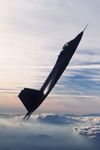
original at www.af.mil |
F-22 Raptor climbs to altitude
(Photo courtesy Lockheed Martin)
The U.S. House of Representatives defense appropriations subcommitte on May 11 endorsed spending almost $4 billion in 2001 for continued development of the F-22 Raptor. The $3.96 billion allotment would pay for 10 initial production planes and advance funding on 16 more of the next-generation air superiority fighters. The F-22 Raptor, developed at Aeronautical Systems Center, Wright-Patterson Air Force Base, Ohio, is the replacement for the F-15 Eagle air-superiority fighter and will become operational early in the next century. It combines stealth design with the supersonic, highly maneuverable, dual-engine, long-range requirements of an air-to-air fighter, and it also will have an inherit air-to-ground capability, if needed. The F-22's integrated avionics gives it first-look, first-shot, first-kill capability that will guarantee U.S. air dominance for the next three decades. |
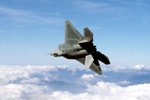
original at www.af.mil |
F-22 Raptor Air-Superiority Fighter rolls left
(Photo courtesy Lockheed Martin)
The U.S. House of Representatives defense appropriations subcommitte on May 11 endorsed spending almost $4 billion in 2001 for continued development of the F-22 Raptor. The $3.96 billion allotment would pay for 10 initial production planes and advance funding on 16 more of the next-generation air superiority fighters. The F-22 Raptor, developed at Aeronautical Systems Center, Wright-Patterson Air Force Base, Ohio, is the replacement for the F-15 Eagle air-superiority fighter and will become operational this century. It combines stealth design with the supersonic, highly maneuverable, dual-engine, long-range requirements of an air-to-air fighter, and it also will have an inherit air-to-ground capability, if needed. The F-22's integrated avionics gives it first-look, first-shot, first-kill capability that will guarantee U.S. air dominance for the next three decades. |
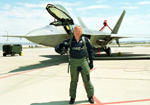
original at www.af.mil |
Edwards F-22 test pilot wins Yeager Award
(U.S. Air Force Photo)
Jon Beesley earned the Yeager Award for his work in the F-22, F-16 and F-117A fighter programs. |

original at www.af.mil |
F-22 Raptor 4004 rolls out
(Photo courtesy Lockheed Martin)
Wearing the appropriate camouflage scheme, Raptor 4004 -- the first F-22 to be equipped with a revolutionary integrated avionics suite -- rolls out of the program's state-of-the-art coatings facility here. Raptor 4004 is expected to make its inaugural flight later this summer, and join the F-22 program's combined test facility at Edwards AFB, Calif., by fall. |
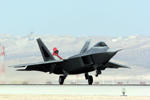
original at www.af.mil |
F-22 flight tests resume
(U.S. Air Force Photo by Derk Blanset)
F-22 Raptor test aircraft 4002 lifts off from Edwards Air Force Base, Calif., June 5 after flight testing resumed for the Air Force's next-generation fighter. Testing had been temporarily delayed until an F-22 tiger team could evaluate the cause of hairline cracks in the canopies. |
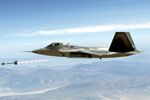
original at www.af.mil |
F-22 successfully fires AIM-9 missile
(U.S. Air Force Photo by Judson Brohmer)
An AIM-9 Sidewinder missile successfully launches from an F-22 Raptor during a launch test Tuesday, July 25. The major milestone test evaluated the next-generation fighter's ability to fire an air-to-air missile from an internal weapons bay. Its primary air-to-air role, the F-22 will carry six AIM-120C and two AIM-9 missiles. For its air-to-ground role, the F-22 can internally carry two 1,000 pound-class Joint Direct Attack Munitions (JDAM), two AIM-120C, and two AIM-9 missiles. |

original at www.af.mil |
F-22 Raptor tests Gatling gun door at high speed
(U.S. Air Force Photo by Judson Brohmer)
The F-22 Raptor's internal-mounted M61A2 six-barreled 20mm lightweight Gatling gun's (upper right wing) hydraulic door was tested during a recent flight test of Raptor 4002 above the Mojave Desert. The successful test was designed to see how the door would react when opened at high speeds. Built by General Dynamics in Burlington, Vt., the gun can fire 6,000 rounds per minute, although the Raptor usually carries only 480 rounds. Almost all current U.S. military fighters and attack jets have been equipped with the M61 or its follow-on models since the 1950s. Consequently, the upgraded gun seems a perfect fit for the next-generation fighter. |
^^ TOP ^^
|

